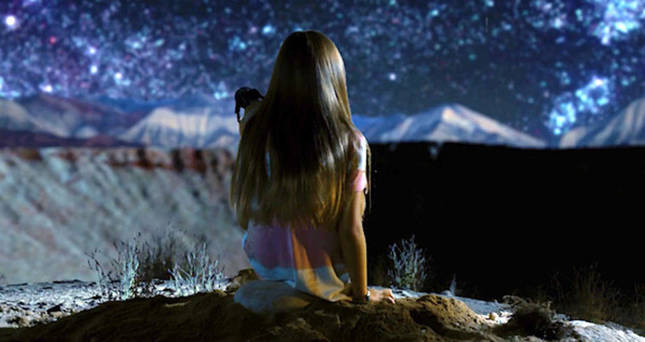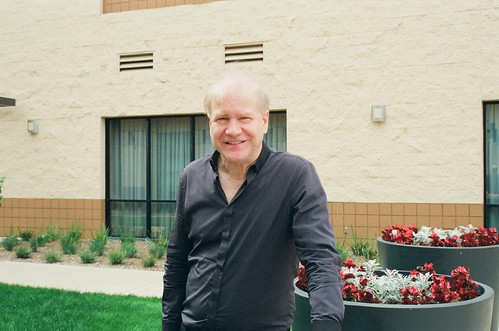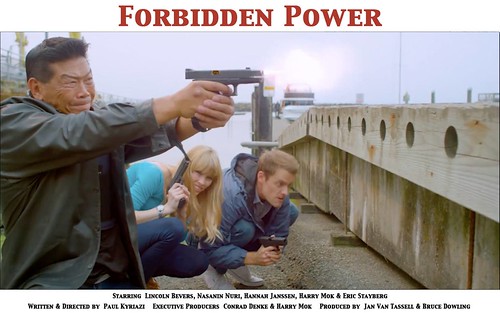Movies & TV / Columns
Paul Kyriazi Talks w/411 About His New Film Forbidden Power

The 411 Interview: Paul Kyriazi
Paul Kyriazi is a writer, movie director and producer who specializes in low budget genre movies. His first movie, Death Machines, came out in 1976 (check out my review of that here). Kyriazi has also directed The Weapons of Death, the classic Ninja Busters (check out my review of that flick here), One Way Out, and Omega Cop, his last movie for almost thirty years. This year, Kyriazi is back in the director’s chair with Forbidden Power, an adaptation of his book of the same name. In this interview, Kyriazi discusses with this writer the making of Forbidden Power, why he decided to get back into making movies, and more.
**
Bryan Kristopowitz: Why did you decide to make Forbidden Power your next movie?
Paul Kyriazi: To continue as a movie-freelancer, I’ve always read empowerment books and gone to seminars. So, it stands to reason that I’d be attracted to stories with characters that are empowered; the Wolfman via animal bite, Star Trek’s “Where No Man Has Gone Before” where the hero is empowered by a strange electrical shock, Lucy and Limitless characters empowered by drugs, just to name a few.
However, there’s never been an empowerment via sex movie, even though men are often empowered by women in real life. That idea sparked my imagination to try, as much as possible, to do a realistic story about a young man who receives this power via mysterious woman. But not super human powers, just a little boost in physical and mental powers.
BK: Why did you wait almost thirty years to make another movie?
PK: When I finished Omega Cop in 1990, the drive-in and downtown action movie theaters were closing down in favor of the multiplexes, so it was difficult to get financing for independent movies. I tried hard, almost got one financed, but didn’t. When I saw Pulp Fiction with its novelistic approach, I thought I would convert two of my screenplays into novels and then into full-cast audio books. This was a dream for me because I got to hire movie stars that I grew up watching them in the theaters; Rod Taylor (The Time Machine, The Birds) Robert Culp (I Spy), David Hedison (The Fly, Voyage to the Bottom of the Sea), Russ Tamblyn and George Chakiris from West Side Story, plus 21 other name actors. I was in heaven working with them.Then, when Amazon announced they would let independent producers upload and sell their own movies on their site, with no need to go through a money stealing distributor, I saw it was time to take a chance and make another movie. The other reason is the development of the 6K Dragon video cameras that equal 35mm film, which meant I could shoot faster and edit faster, thus keeping the budget lower than my filming days.
BK: How was directing Forbidden Power different from your last movie, 1990’s Omega Cop?
PK: I was always good at scheduling and not afraid to try to make a big looking movie on a tight schedule. For Omega Cop we filmed 21 days straight, no days off, to save on equipment rental and hotel rooms for cast and crew. Because of the speed of doing Forbidden Power in video and being smarter with scheduling and more efficient with camera set ups, we filmed the whole thing in 17 days, but with weekends off. Also, I got more creative support from the cast and crew than I ever had before. They kept coming up with ‘bonus’ ideas for each scene. Even the sound boom operator came up with a great idea in a climactic scene.
BK: How did you adapt your novel Forbidden Power into the script for the movie Forbidden Power? What changed, if anything, in terms of the story?
PK: It’s actually a 100-page novella written in the first person and present tense. I used first person narration in the movie. The novella used a flashback structure of the hero telling most of the story via flashback. My story consultant, David J. Moore, advised me to not use the flashback technique and keep the story as a straight narrative. With that idea, the movie structure really came alive for me. Also, the movie needed a third act, which you’ll see very clearly in the movie. With the novella, I hinted at the answer to the mystery, but in the movie I show exactly the answer to the mystery on screen.
BK: Where did you film Forbidden Power?
PK: It was filmed in Seattle, Washington using Victory Studios there as a base. Then we quickly did some scenes in Las Vegas and Arizona with a 2nd unit crew.
BK: How did you cast Forbidden Power? How did Nasanin Nuri come to your attention?
PK: I live in Japan and cast the entire movie using the internet, looking at Seattle based casting companies. They post photos and resumes of their actors online. I mainly went for physical types to fill the parts, sometimes casting with type and sometimes against type. The actors I chose went to Victory Studios for auditions and 90% of the final cast were made up of the people I chose via the internet. Some of them I interviewed via Skype.However, finding the leading lady didn’t come so easy. The story required her to be a Native American with a physicality, voice and mannerisms to make the audience believe that the hero would quickly be addicted to her. When Seattle casting companies didn’t have the perfect actress, I searched everywhere I could via the net. Finally, my co-producer, John Wright, put an ad in a casting magazine. He received about 80 photos, many of which were not for the type we needed. But in that bunch of photos was Nasanin Nuri’s photo. I talked to her via Skype and found, not only did she have the look, but had the voice as well. I was worried about getting a look and voice that would be good and figured I’d have to dub in the voice of whoever had the right look, like they had to do with the first few Bond Girls. However, when I heard Nasanin’s voice, I knew she had the whole package for the part.
BK: How did Harry Mok get involved?
PK: I’ve known Harry since making Ninja Busters in 1983 where he performed many stunts. Then he hired me to edit his movie production of The Vineyard. We’ve kept in touch over the years via our martial arts connections and worked on some scripts together. So, any movie that I do would naturally involve him.
Harry worked with Sylvester Stallone on Rambo: First Blood Part II and now is executive producer on Animal Crackers, an animated movie with the voices of Sylvester Stallone, Danny DeVito and more. However, the main reason I have Harry in this movie is because of his powerful look and action skills. I knew he’d make a great character for Forbidden Power, a character that was not in the novel. So, I wrote the character of Chang especially for Harry.
BK: How long did it take to make Forbidden Power, from finishing the script to finishing post-production?
PK: In February of 2017, I decided to make the movie and started on the screenplay. Also, I started the casting and searching Seattle locations via the internet. Mid-August has the least rain in Seattle, so I set the date for August 21st. I arrived three weeks before that for pre-production. By mid-September we finished shooting and went directly to editing, special effects and sound work. On December 15th we held screenings at Victory Studios and I flew back to Japan. From January to mid-March I made sound and picture changes via the Internet. It’s now April 3rd and we are preparing the movie file for uploading onto Amazon. So that’s 13 months from starting the screenplay to the finished product.
BK: What was the most difficult aspect of making Forbidden Power?
PK: It was getting the movie finished in the 17 days. I always try to get the biggest looking movie I can, a movie with lots of good camera set ups, large cast and the most action I can.
Every day I had to juggle the time allotted to complete each scene. On the third day, I scheduled what I called ‘hell day’, which was completing six different scenes in one day, including Harry Mok fighting 12 thugs at a night time exterior location. We used three fog machines and a 20-foot boom on that scene. We worked from 8am to 2am that day.
Some action at the end of the movie that I had planned had to be skipped just to get the movie finished. However, looking back, I got more production value and story than I had dreamed of when I first started planning the project, so I’m very grateful.
BK: Is there a chance we’ll see a Forbidden Power 2? The ending suggests that there’s more story to tell.
PK: Yes, I’m working on the script now because I like those characters and this special mix of mystery, thriller and action is what I like to do.
BK: How can we see Forbidden Power?
PK: It will first go on the Amazon movie site for rental or purchase and then be sold to other countries.
BK: What’s your favorite song from The Eagles?
PK: They have many great songs that I like, but it’s an easy choice for me: “sparks fly from her fingertips”: Witchy Woman. I wish I could have purchased that song for Forbidden Power as it describes our mystery woman perfectly.
**
A very special thanks to Paul Kyriazi for agreeing to participate in this interview and to david j. moore for helping set it up.
You can check out the Forbidden Power Facebook page here
You can check out Paul Kyriazi’s website here.
Check out my review of Forbidden Power here.
Images courtesy of Paul Kyriazi and david j. moore.










